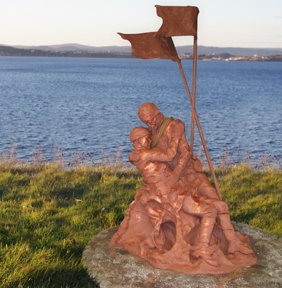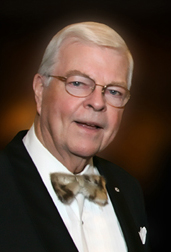Bedasse will be first Jamaican in Pro Mazda
 The national motto of Jason Bedasse’s native Jamaica — “Out of many, one people” — speaks of the diversity of the population of that Caribbean nation. Bedasse has a twist to that phrase as his personal motto: “Out of many, one driver.”
The national motto of Jason Bedasse’s native Jamaica — “Out of many, one people” — speaks of the diversity of the population of that Caribbean nation. Bedasse has a twist to that phrase as his personal motto: “Out of many, one driver.”
Bedasse, who has joined M1 Racing for selected events in the 2014 Pro Mazda Championship presented by Cooper Tires, will be the first driver from Jamaica to compete in that Mazda Road to Indy series.
Click here to read the full story.
Turner reflects on making a difference in the lives of Canadians

By Roderick Benns
When former Prime Minister John Turner reflects on the years he spent as a progressive minister under both Lester Pearson and Pierre Trudeau, he is satisfied he made important social changes for all Canadians.
Asked to consider a time in politics when he knew he was making a difference in Canadians’ lives, Mr. Turner says he “had a lot to do with a number of situations that affected people directly.”
Mr. Turner pointed out he was involved with legislation and departments that had many direct connections to Canadians under both Prime Ministers Pearson and Trudeau.
“For instance, I always believed in balancing individual rights against those of corporations,” says Mr. Turner.
That’s why the former leader says he was proud to introduce the bill in the House of Commons in 1967 that created the Department of Consumer and Corporate Affairs – and then he led it.
“I headed up the Department of Consumer and Corporate Affairs which gave a balance in the legal rights between consumers and corporations,” Mr. Turner says.
As John Turner biographer, Paul Litt writes, this “fit with his concern for the rights of the average Canadian in the face of impersonal bureaucracy…”
Litt notes that for Mr. Turner it was “also a matter of social justice; the poor…commonly paid more because they lacked access to consumer choice and got stuck with the highest interest rates.”
Under former Prime Minister Pierre Trudeau, Mr. Turner was appointed minister of justice in 1968 – a post he held for four years. It was during this time that Mr. Turner sponsored Criminal Code reform.
“At the justice department, I established the federal court of Canada,” where trials and hearings were heard across Canada, he says. The court also strengthened the rights of individual defendants on trial. Mr. Turner also got rid of the tradition of party patronage in the appointment of judges. He also set up the Law Reform Commission.
During a key time in Canada’s history, Mr. Turner would also direct the Justice Department under the War Measures Act. He was also minister of finance from 1972-1975.
After years as a successful lawyer, Mr. Turner was convinced to seek the leadership of the Liberal Party in 1984. Mr. Turner won and became prime minister when Mr. Trudeau left office. Losing to Brian Mulroney in 1984, he nonetheless doubled the Liberal seat count in the next election, in 1988. He remained Liberal leader and leader of the opposition until 1990. He then retired from politics once again to resume his legal career.
Did You Know?
John Turner is known as Canada’s ‘fastest prime minister,’ for his distinguished athletic record while in university. In the late 1940s, Turner was one of Canada’s top sprinters. In fact, he set the Canadian record in the 100-yard dash, running it in 9.8 seconds in 1947.
The University of British Columbia sprinter also dominated the 100-and-200-yard events. He even qualified for the 1948 London Olympics, but a car accident closed this window of opportunity.
Mr. Turner, a Rhodes Scholar, studied law at Oxford and in 1954 was called to the Quebec Bar.
Click here for original article.
2014 Federal Budget: Economic Action Plan
“Implementing policies focused on raising Canada’s economic potential and creating stable, well-paying jobs continues to be the Government’s top priority. Economic Action Plan 2014 takes additional steps to achieve these objectives, especially returning to budget balance in 2015. Maintaining focus on these priorities is the best way to ensure that Canada is prepared to weather any future economic storm that may arrive from outside our borders. It is also the best way to ensure that Canada’s future is a prosperous one, with a healthy, competitive economy fuelled by low taxes, and government services that are sustainable for generations to come.”
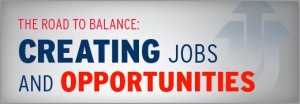
Click here for the 2014 Federal Budget
John Turner says he is in favour of a ‘formal’ Canadian prime ministers’ club

By Roderick Benns
Canada’s 17th prime minister says he is in favour of a formal prime ministers’ club that could concentrate on national and international issues.
Former Prime Minister John Turner says the idea of a club where former leaders gather to meet doesn’t have to be in the American tradition.
“We don’t seem to have that tradition here, like the Americans do. If we did it, we could be a little more formal and less haphazard,” he says.
In the U.S., the presidents’ club was established at Dwight Eisenhower’s inauguration by Harry Truman and Herbert Hoover.
According to the book The Presidents Club: Inside the World’s Most Exclusive Fraternity, by Nancy Gibbs and Michael Duffy, “Truman enacted one Hoover recommendation after another, and sent the 71-year-old former President on a 50,000-mile mission around the world: with Truman’s encouragement (he)…met with seven kings, 36 Prime Ministers and the Pope. When he was in Cairo in April of 1946, he and Truman did a joint radio broadcast exhorting Americans to conserve food…And it worked; by the end of that summer, Truman could announce that America had shipped five and a half million tons of grain to the ravaged regions of Europe, thereby keeping the nation’s promise and forestalling a humanitarian catastrophe.”
However, after this auspicious beginning the cooperation level of the presidents would stall and occasionally be revived depending on circumstances.
After Nelson Mandela’s death, Canadians were recently surprised to see Prime Minister Stephen Harper aboard Royal Canadian Air Force 001, flying to the funeral with three of his predecessors — Kim Campbell, Jean Chrétien and Brian Mulroney. Former Prime Minister Joe Clark met the three in South Africa.
Even public photo ops among former PMs are rare. However, Mr. Turner tells Leaders and Legacies that it’s logical for former leaders to meet and discuss issues.
“Overall it makes some sense to discuss international and national concerns.”
In a previous interview with Leaders and Legacies, former Prime Minister Paul Martin said he will soon be working on an initiative that will involve one former prime minister — Joe Clark. He said it has something to do with Aboriginal Canada, the cause closest to Mr. Martin’s heart.
When asked who else he might like to work with and on what issue or cause, Mr. Martin singled out former Prime Minister Brian Mulroney as someone who “is very interested in Aboriginal issues.”
Mr. Martin says that working with former leaders for Aboriginal Canada and Aboriginal education would be something he would be interested in.
“I would welcome any involvement that helps with this.”
Click here for original article.
Creating a Lasting Legacy
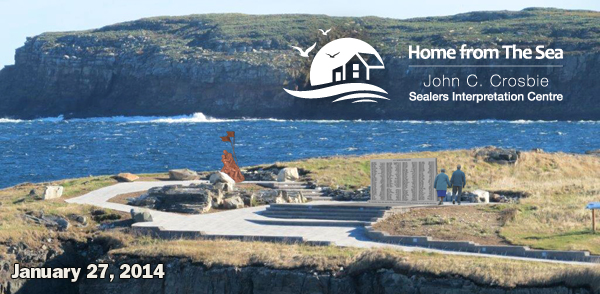
 |
On March 31/April 1, 2014, we will mark the 100th anniversary of this province’s most devastating sealing disasters. Many brave Newfoundlanders and Labradorians risked their lives on the treacherous ice floes of the North Atlantic to support their families and build their communities. Many did not return. Many were left to mourn. In commemorating the men and women who made incredible sacrifices to build our beloved province, we will ensure that they will never be forgotten.
On June 19, 2014, we will unveil the results of our efforts to create a lasting memorial in Elliston. There are four components to our project: the John C. Crosbie Sealers Interpretation Centre; a Memorial Statue; a Memorial Monument; and an Interpretive Path. We are excited to be nearing our fundraising goal and the successful conclusion of this project. We still need your help to get there. Thank you to all our donors, current and future. We know you will be proud to have been part of this project.
|
 |
|
John C. Crosbie Sealers Interpretation Centre Through interpretation, including art, artifacts and multimedia, the Centre will bring to life the stories of sealing from our earliest aboriginal people to the present day. As a museum, gallery and space for reflection, the Centre will be unique to our province and a first worldwide in its singular focus on sealing and sealers. |
 |
|
|
|
Memorial Statue |
|
|
Granite Memorial |
|
|
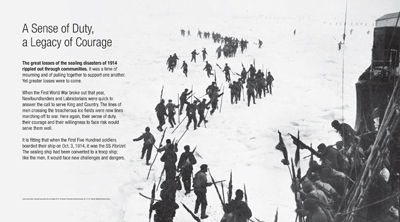 |
Interpretative Path Connecting the Interpretation Centre and Porter’s Point, along vistas of the sea, interpretive panels will tell some of the many stories that illuminate the central role sealing has played—and continues to play—in the lives of Newfoundlanders and Labradorians. |

|
| The Honourable John C. Crosbie Honorary Patron |
John Turner calls Ukraine political unrest a ‘political tragedy’

By Roderick Benns
Just one decade ago, former Prime Minister John Turner recalls the unforgettable demonstration of democratic power in Ukraine.
After a late November, 2004 election in which most election observers reported massive fraud on the part of the governing party, a re-run of the presidential election occurred about a month later after great Ukrainian and international pressure.
Mr. Turner, now 84, was a key witness to that historic second chance. That’s because then-Prime Minister Paul Martin handpicked Mr. Turner to lead the largest election delegation in Canada’s history, calling him a “tremendous defender of parliamentary democracy.”
Mr. Turner led a 500-person monitoring team under the first-ever mission of the Canada Corps.
“I led the team to Kiev and across Ukraine to patrol Election Day. It was the Orange revolution and it was one of the greatest demonstrations of democracy I have ever witnessed,” Mr. Turner says.
Turner, who still works five days a week in Toronto doing promotional work in energy and the environment, is dismayed at the state Ukraine finds itself in today.
“The last 10 years have been a political tragedy. You have to listen to the people,” Mr. Turner tells Leaders and Legacies.
“Those in charge of political affairs of the country need to open their ears and their eyes and be available to the people – that’s the secret to success.”
Canada was among the first to recognize Ukraine’s independence from the Soviet Union more than two decades ago. Canada’s connection with Ukraine has been strong, anchored by massive waves of immigration from the country since the turn of the twentieth century under former Prime Minister Wilfrid Laurier.
Democracy not an accident
The example of Ukraine’s lost decade in democratic renewal allows Canada’s 17th prime minister to reflect on Canada. Mr. Turner points out that he spoke to the Kiwanis Club of Montreal in 1963 and advocated for free votes in parliament except for budgets and the throne speech.
“I’m also in favour of strong standing committees, in favour of private members bills, and opening up question period,” said Mr. Turner.
Mr. Turner says Canada must stay “an open country” in practice and spirit.
“Democracy does not happen by accident. Citizens need to be active and parliament needs to be open to the people. There has to be political independence in parliament and in the legislature. That means the role of the individual MP has to be established,” said Mr. Turner.
As for more Canadians choosing to get involved in public life and choosing a political career, Mr. Turner says he has been on several committees over 25 years, exploring why young people don’t want to get involved in politics.
“They point to the financial sacrifice, marriage pressure, media pressure on one’s private life, and that the job itself isn’t worth it anymore – that the role of the individual Member of Parliament has diminished.”
Because of all these reasons, says Mr. Turner, “we have to be active in our own democracy” and consider how to bring in new people to renew our institutions.
Click here for original article.
Celebrating Ariel Sharon – my personal experience
Last year, Canada, along with most of the rest of the world, celebrated the 65th anniversary of the founding of the State of Israel. Yom Ha’atzmaut is a modern holiday celebrating the day Israel’s first prime minister, David Ben-Gurion, publicly read Israel’s Declaration of Independence on May 17, 1948.
In November 2005, Israel’s then Prime Minister, Ariel Sharon, invited the world to commemorate the 10th anniversary of the assassination of its former Prime Minister Yitzhak Rabin. Representing Canada at this event was former Canadian Prime Minister John N. Turner.
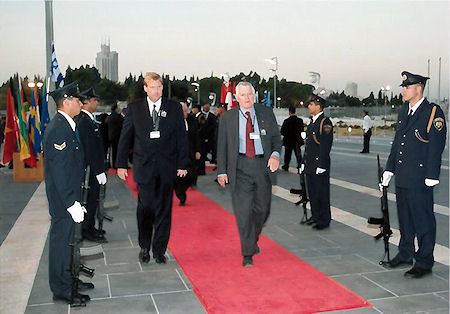
Accompanying him to Israel, we met with Ariel Sharon at a special event at the Knesset and stared into those expressive eyes and held his hand in a tight shake that seemed interminable. We attended numerous state events in Jerusalem, visited the Holy City, prayed at the wailing wall, attended a special session at the Knesset and were given a private tour of the National Museum of Art in Tel Aviv. It was at this event that Ariel Sharon’s invitation to the world made perfect sense to me. We were met at the front doors of the museum by media and the curator of the museum, a tall blonde perfectly tanned forty-something year old woman. She immediately embraced Mr. Turner and invited him on a tour. He asked her, “…wow, you speak such great English and you’re so blonde, are you Jewish?” Her answer was even more perfect. “Yes I’m Jewish, Prime Minister, but even more importantly, I’m Israeli?”
For most people, an opportunity to see a special part of the world like Israel conjures up religious and historic significance. For us it was recognition that Ariel Sharon, the great political tactician and military strategist, wanted the world to remember the melancholy state of tension in Israel – and it’s surrounding neighbours.
He was a special man with a fervent zeal for the state of Israel and its special place in the world. His invitation to attend the Rabin event saw hundreds of world leader take the opportunity to be there especially the United States who sent James Baker, Condaleeza Rice and Hilary and Bill Clinton.

In his official address to attending world leaders and invitees at the Knesset, Sharon described the special condition of Israel and lectured the world that solutions to the easing tensions in Israel are not easy and are certainly not transparent – but peace is necessary. It was truly one of his better moments to shine for the world’s media.
We left Israel after an extended stay in both Jerusalem and Tel Aviv feeling buoyed about meeting Sharon and by the special relationship Canada shared and continues to share with Israel. Throughout his career, Turner had been to Israel many times, but never with this much intimacy or understanding of her place in the world.
Shortly after our visit to Israel, we were stunned and shocked by news of Ariel Sharon’s stroke in January of 2006, we thought his personal strength would help him get through it, but for years we wondered. It was sad to hear that he has died, but for John Turner and me, we believe his legacy is as secure as his fight for peace.
A Soldier’s Story
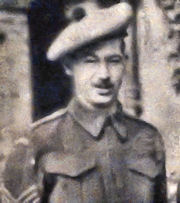 My grandfather is a war hero. For years I admired his ability to march to the cenotaph every November 11 with members of the Legion in Niagara Falls- even in his 70’s. Some people, including my own mother, used to say that November 11 was always an excuse for old fogies like Blackie to get drunk – I never thought that and always reveled at his medal festooned chest on November 11. I always wanted to know what he endured on one blustery day in June of 1944. I had opportunity in the latter part of the 1970’s when he and I drove together for the first time to Ottawa from Niagara Falls to attend the annual reunion to celebrate their regiment’s efforts on D-Day and hear the stories – some good, some troubling. Those stories have stuck with me and struck me awesome to this day.
My grandfather is a war hero. For years I admired his ability to march to the cenotaph every November 11 with members of the Legion in Niagara Falls- even in his 70’s. Some people, including my own mother, used to say that November 11 was always an excuse for old fogies like Blackie to get drunk – I never thought that and always reveled at his medal festooned chest on November 11. I always wanted to know what he endured on one blustery day in June of 1944. I had opportunity in the latter part of the 1970’s when he and I drove together for the first time to Ottawa from Niagara Falls to attend the annual reunion to celebrate their regiment’s efforts on D-Day and hear the stories – some good, some troubling. Those stories have stuck with me and struck me awesome to this day.
The soldier’s name was C. Grange Black – all his life he was known as Blackie. He married his sweetheart, Frances, in 1932 when the world was tense. Seven years later, as a father of three and a Sergeant in the 43rd Cameron Highlanders Regiment of Ottawa, he kissed his wife and kids good-bye, marched his troop out of Lansdowne Park and onto a ship headed for Iceland. While in Iceland he and his regiment were deployed for what he called menial military work known as “garrison duty” until he and his mates were deployed to England in 1941. There he marched on a daily basis, trained with a rifle and kit and, like his mates, yearned to earn his keep by fighting in Europe. On 6 June 1944, the 43rd was the only Ottawa regiment who had trained to land on D-Day at Juno Beach in what became known as Operation Overlord.
At reunions in Ottawa with Blackie, he recounted to me myriad stories of his departure early in the morning of June 6, 1944 from Portsmouth; he often recalled having no idea of what he would be up against when he landed at that stretch of the beach in Normandy code named Juno. The trip across the channel was rough, the swells were high and the temperature was cold. It was early morning – he said that on the trip across, he was joking with his men and singing off-key as he often did with his grand children in later years, but, he’d recount, when he neared the beach and he heard the whizzing of bullets and they smelled the fowl stench of gun powder, he become uncontrollably frightened. The ramp to his LCA lowered and he at the back ordered his 35 other troops off the vehicle – that was lucky for him because some were cut to shreds by bullets from the German pillboxes at the top of Juno Beach. Before he died in 1987, he confided to me that he jumped over the side of the LCA, grabbed one his soldier mates whom he thought was having a hard time getting his feet and raced with him to the beach. In fact, his colleague wasn’t struggling, he said, he was already dead and that fact gave Blackie the advantage he needed to advance protected from the hail of bullets using his mates body as a shield. That single act apparently haunted him for years – often making him weep in private.
Once on the beach, he discarded his Enfield rifle for a more effective Bren machine gun, he loaded himself up with ammunition he found and crossed the barbed wire to the advance site – all the while dodging bullets. He had soiled his pants and was wet from seawater, sweat and urine. He had no idea that the four years previous training would prepare him for a mere 600-metre assault. But it worked! He and several of his Canadian mates subdued the Germans taking them prisoner. He recounted one story in particular about a German prisoner resplendent in warm wool uniform while Blackie, freezing and wet, decided to beat him up for his pants, his undergarments and his boots. He also confided that he had taken a German luger complete with its breechblock – as a souvenir. I remember seeing and holding it years and years later.
Following the landing on D-Day, Blackie and his regiment fought in almost every battle in the northwestern Europe campaign ending a few months later and until the end of the war he and several of his soldiers ended up in Huemen in the eastern part of Holland to help liberate it from Germany. He returned there several times since the war ended – marching proudly down its main street to the delight of many grateful Dutch citizens.
Blackie died in 1987 in Niagara Falls leaving at the time, his wife of 55 years, five children, 17 grandchildren and two great grandchildren. Blackie lived in Niagara Falls for almost 17 years and his life there was marked by him being named as Man of the Year one time, he was the biggest booster of the Niagara Falls Flyers hockey team, was a huge fund-raiser for the Legion and the Arthritis Society and never missed a reunion in Ottawa for the 43rd regiment with me. The year he died, I attended the regiment’s reunion in his honour and, to mark his death, donated his barracks box to the museum at Cartier Drill Square in Ottawa including that German Luger.
He has a brick on the Juno Beach wall in Normandy prominently displaying his name, rank, regiment and years served. I’ll remember him as a Canadian hero – a war hero!
Jr Economic Club Summit in Toronto
Last month, Kealey & Associates was a sponsor of the annual Jr Economic Club Summit in Toronto.
The Jr Economic Club’s mandate is to promote financial literacy among Canadian youth by teaching them about money management, saving and investing.
This year was the first year for the Jr Economic Club Boot Camp where teams of students pitched their business ideas to a panel of leading business people. The ideas ranged from apps to help kids eat right to microchips for golf balls.
The top 3 winning teams won education sponsorships.
K&A is proud to support the Jr Economic Club of Canada to help today’s youth on the path to financial literacy and independence.
Click to view CP24/CTV News at Six video clip.

